 |
|
|

Location:
The bird rookery at
St. Augustine Alligator Farm Zoological Park,
St. Augustine, Florida
(posted March, 2019)
|
 Bird Rookery
Bird Rookery
at St. Augustine Alligator Farm Zoological Park,
St. Augustine, Florida
The bird
rookery at St. Augustine Alligator Farm/Zoo is mainly active
from March thru June, as that's when the birds come to build
nests, display, mate and raise chicks. The activity may spill
over into late February and into July, but March thru June is
the most active time. (Check out the park's web site for their
bird activity schedule for more information on timing.)
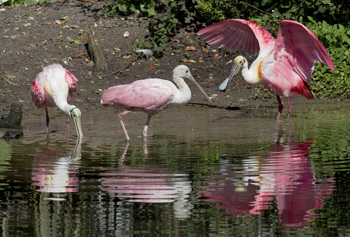
|
| Spoonbills in the gator pool. |
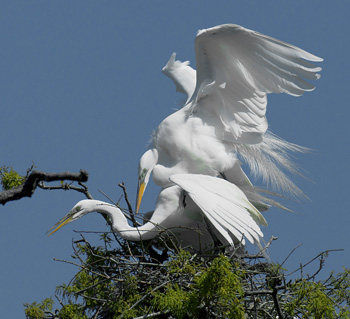 |
| Great Egrets mating |
I visited
the park/zoo in early March, 2019, as part of a 9-day photo
expedition across Florida. I had come to Florida specifically
to photograph species that don't come to North Carolina....
Roseate Spoonbill, Woodstork, Reddish Egret and Anhinga, as
well as other species found in NC that aren't present during
mating season with their display plumage. The park/zoo web site
promised Woodstorks, Great Egrets and Spoonbills during March,
and all three were there as promised. But there was little else.
It was a challenge to get good images without limbs and branches
blocking any clear view. I understood that would be an issue
going into it, though I thought surely there would be more trees
and considerably more room for me to move along the boardwalk
to pick and choose my subjects. The truth is that you can set
your tripod in one spot at the end of the boardwalk and pan
it 360 degrees to photograph everything there is to see in the
rookery area. Lucky for me on the day I went, most of the people
were there for the alligators. They tended to stay farther up
on the boardwalk and not gathered near the birds. Only a handful
of photographers were there for the birds, so I never felt cramped.
I would not want to be there on a day when more photographers
come (like weekends or later on in the nesting season). It was
a good thing I came mid-week and early in March when things
were just getting started.
The entrance
fee is a bit steep for bird photography. It cost over $45 (even
with the senior discount) for me and my wife to get in to take
photos. That frankly made it no bargain. You're paying for all
the alligators and the "show and tell" entertainment,
not the birds. After all, it's an alligator farm and "zoo",
and a tiny one at that. It's not a bird park or wildlife refuge.
You are actually the oddball looking at the birds, not the folks
gawking at the alligators. The bird rookery is just a handy
incidental happenstance during four months of the year, because
the birds like the alligators under the trees keeping all the
egg pilfering varmints (racoons and such) away from the nests.
I've never held any fascination with alligators at all. One
visit was enough for me. I won't pay to do it again.
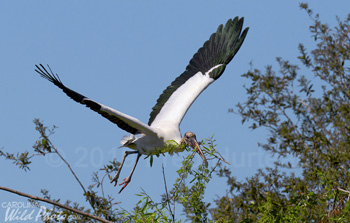
|
| Woodstork bringing nesting material |
You might
have heard there is a special photographers pass you can get
to gain early admission and extended hours without the other
visitors. Itís actually an Annual Pass costing over $100, and
the special extended hours are limited to 4 months during the
rookery season. The rest of the year itís just an annual pass.
If you do the math, itís actually a good deal for local photographers
who can come often. For the rest of us who have to drive hundreds
of miles to get there, not so much. If you spent everyday for
a week coming there to photograph while in Florida, youíd save
money on admission. But honestly, one day was all I needed to
photograph everything there was to shoot 10 times over while
standing in one spot. I canít even imagine spending 4 or 5 days
there trying to get my money's worth.
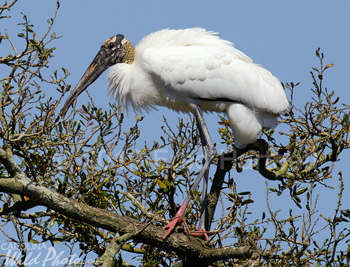 |
| Woodstork |
Moving away
from the location logistics and focusing on a photographer's
point of view doesn't make things much better. With so much
twigs, leaves and branches not only in front of, but also behind
your subjects, it makes for busy backgrounds that are ugly and
wickedly cluttered. Wide open f/stops hardly help to blur the
background at all. Even if blurred, they're still horrifically
busy. The Woodstorks heads looked like bark-covered tree limbs,
making them even harder to distinguish from the jumble of limbs
in the background. Catching them against the blue sky made a
better background. You're mostly shooting white or light subjects
against a dark background, with bright patches of sky behind
that. You'll have to stay alert to the changing lighting conditions
to avoid blowing out the bright feathers. You pretty much have
to expose for detail in the bright feathers and try to pull
detail out of the dark stuff later with your software. And I
recommend using a camera body that can lock focus onto your
subject instead of all the vegetation around or in front of
the subject. It will tax your skills for sure.
I was particularly
keen on getting images of the Spoonbills on this trip. But every
single mated pair of Spoonbills there had nested behind so much
vegetation, and in trees so far behind the other birds, that
I got no nesting shots of them at all. I could barely even see
them. Plenty of the non-nesting juvenile Spoonbills roosted
close to the boardwalk out in the open, but not the adults.
However, the adults did like the pool down below with the alligators
for splashing and bathing, but that was ten feet lower than
the boardwalk, and hardly a good angle for shooting. Everything
else was shooting upwards.
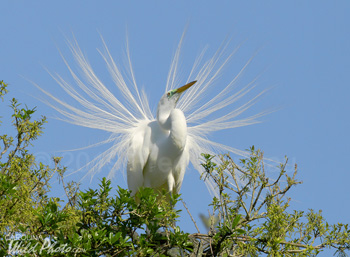
|
| Great Egret displaying |
The birds
seemed oblivious to all the people there. At least one juvenile
spoonbill took up a roost so low in a tree over the boardwalk
that I could have reached out and touched it. They seemed to
have no fear at all of the people going by. The egrets, Spoonbills
and Woodstorks were all busy building nests and courting. They
flew about breaking twigs from the bushes and trees, and carrying
them back to the nests. Though I used a 500mm f/4 with a 1.4x
TC on a 1.3 crop factor Canon 1D Mark IV body (about 910mm effective
reach), it was not too much lens most of the time. I did employ
another 1D Mark IV with a Canon 100-400mm v.II zoom for the
closer birds and most flight shots. Those two lenses gave me
all the reach I needed.
Great Egrets
repeatedly flew within 5 feet of me bringing twigs, as they
zipped to and from their mates on the nest. If you stayed diligent,
there were frequent opportunities for flight shots. But they
might be 5 feet away, or 50 feet away. Having the right lens
ready was a challenge. And staying alert for mating activity
might net you mating shots, if you were lucky enough to have
the birds clear of interfering vegetation.
 |
| Great
Egret in breeding plumage |
The most
photogenic birds at the park were the Great Egrets, a species
of which I already have more than enough photos from North Carolina.
But....the images from the alligator park are different. These
birds had their wispy courting feathers, and one bird in particular
continually dazzled me with his persistant efforts at attracting
a mate. Though high up in a tree away from the other birds where
no others competed, his hours of efforts seemed futile. The
good part was that he perched above the vegetation with only
a clear blue sky behind him, allowing his brilliant white plummage
to show up in great detail. Though I had a field day with his
valiant efforts at displaying, it seems no females were impressed.
When I left just before closing time, he was still at it, and
all alone.
A couple
of last thoughts here. The restroom facilities were good. No
problems there. It was obvious that on a really busy day, parking
could become an issue. Finding the ticket booth and getting
into the park with camera and tripod was a hassle though. Signage
directing foot traffic from the parking lot to the proper ticket
booth entrance was poor. The room with the ticket counter was
small. It was packed with so many people milling about that
I didn't think I was going to get in carrying my telephoto and
tripod, while wearing a second harness-mounted camera and zoom
lens. Once I got my ticket I felt like a slapstick cartoon character
trying to fumble my way through the stupid turnstile. At least
when I returned after going to lunch, they offered to let me
go around the turnstile with my unwieldy load of gear. There
was but one bench on the boardwalk in the bird rookery area,
so if you want to get off your feet occasionally, bring a portable
stool as I did. They ink stamp your hand when you pay, so you
can come and go during the day with no problem. Just don't wash
off the stamp when washing your hands.
To sum up,
I expected the place to be bigger, and I expected there would
be many more birds than the four or five dozen total there.
Perhaps the numbers would be greater later in March or into
April, but without more trees and boardwalk, where would they
nest? Given the limited space, more birds would only have made
things more chaotic. The backgrounds were mostly horrible. And
though I got some of the photos I was hoping for, including
my only shots of Woodstorks and displaying Great Egrets on the
9-day trip, I'm not sure I'd do it again, knowing what I know
now. The ticket price was certainly no bargain, and now that
I've been there, it falls under the category of "Been there,
done that". I see no reason to go back for another stab at it.
I'll try somewhere else next trip.
|
|
 |
|
 |
